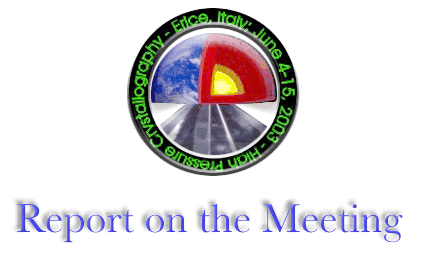
 |
|
From June 4 - 15, 2003 one hundred eighteen total participants convened at the E. Majorana Centre for Scientific Culture, Erice, Italy for the 34th Course organized since 1974 by the so called "International School of Crystallography", one of the more than one hundred cultural sections of the Centre.
This was the first such course dedicated to high pressure research and highlighted the progress, the interdisciplinary aspects, and the bright future of high pressure science. Based upon the anecdotal evidence gleaned by your correspondents, this is likely to be first of a string of similar summer schools on high pressure science. The productivity accompanying the science sessions and extra curricular activities turned an enjoyable scientific event into a memorable experience. Erice, an incredibly beautiful and peaceful setting in any circumstance, was made all the more attractive by fine food, excellent local entertainment, and excursions to nearby archaeological sites The Course covered a wide range of sub-disciplines from solid state physics, organic and solid-state chemistry, geophysics and molecular biology. Invited lectures were punctuated by active discussion, several workshops concentrating on techniques, "best practice" and hands on demonstrations of computer programs. The two poster sessions were lively affairs, and were preceded by an equally lively and enjoyable series of 1-minute presentations by poster presenters. This session was chaired by Malcolm McMahon who later expressed surprise and even some disappointment at not having to wield "the bell" to encourage presenters to keep to time. In all, 88 selected participants from 21 nations were addressed by 30 invited experts, who joined the audience when their talk was not on the programme. This was the first time that an "Erice Meeting" was broadcast live on the web, thanks to considerable effort on the part of the in-house computer staff, led by John Irwin. Remote participants from countries around the world posited questions to speakers via the electronic chat room. The speaker list included leaders in the high pressure field who described
techniques and recent developments, as well as giving insights as to where
the field is heading. The meeting began and ended with inspiring lectures
by directors McMillan (solid state Whole new classes of experiments are being carried out at high pressures, thanks to the increasing availability of synchrotron X-ray neutrons sources at international facilities, improved methodologies, and better area detectors. The possibilities for new, more accurate and more precise science at these facilities were emphasized in lectures by Hausermann (the new APS high pressure facilities) and Angel (more accurate data from diamond anvil cells in the laboratory environment), McMahon (accurate data from powders, single crystals, "poor" single crystals, and various combinations of these), Itie (X-Ray absorption spectroscopy at extreme conditions) and Parise (mapping changes in atomic structure using powder diffraction data). Emerging fields included studies of the effects of pressure on organic materials, addresed by Boldyreva and macromolecular crystallography and other "soft" materials at high pressures, covered by Gruner and Fourme. The recently discovered modulated structures of "simple" elements were discussed by McMahon, their treatment was addressed by Petricek, and possible reasons for their formation and stability were given by V. Degtyareva. Specific topical areas where the power of high pressure techniques to provide unique structural information under the "operating conditions" of important materials included lectures by Kuhs (high-pressure clathrates), Loveday (neutron diffraction studies of ices and ice mixtures), Pusztai (structural studies of high-density forms of amorphous ice), Solozhenko (in situ studies on the synthesis of superhard materials), and Goncharenko (magnetic properties of crystals and their studies at high pressure conditions). Not all high pressure crystallography is necessarily done in situ. Three speakers emphasized materials synthesized at high pressures and recovered to room pressure conditions. These included presentations by Ross (bonding of charge balancing cations in framework stabilized at high pressure), Gauzzi (cuprate superconductors prepared under high pressure) and Armigliato (analysis of localised strains by convergent beam electron diffraction) A three page questionnaire was distributed to lecturers and students at the end of the meeting; a series of purposes and eventual success in them had to be scored from 0 to 4. The overall average, 3.39 (out of 4), fits perfectly with the answer to a final question "How do you score (0 to 100, 100 maximum) the overall value of the meeting to you" ?. There were seventyseven answers with an average score of 85. Copies of the lecture presentations are posted on the web at alternative
green gem here and at
The photo was taken during the closing cerimony, 14 June: you see the award winners: soon after Lodovico, Armi Budzianowski, Stanislaw Filipek, Elena Boldyreva, Toshiya Hirata, - and after Paola, and the awarders Pasternaks - Roger Fourme, Moshe Pasternak, Sergej Kazantzev, Agnes Dewaele, and Diego Gatta. The Directors of the Course, Paul McMillan and Andrzej Katrusiak, "dominate" the group from the high far end......(a deserved "high table" ?) This report has slightly been adapted by Lodovico out of an original text produced by Sol Gruner, John Parise and Paul McMillan.
|